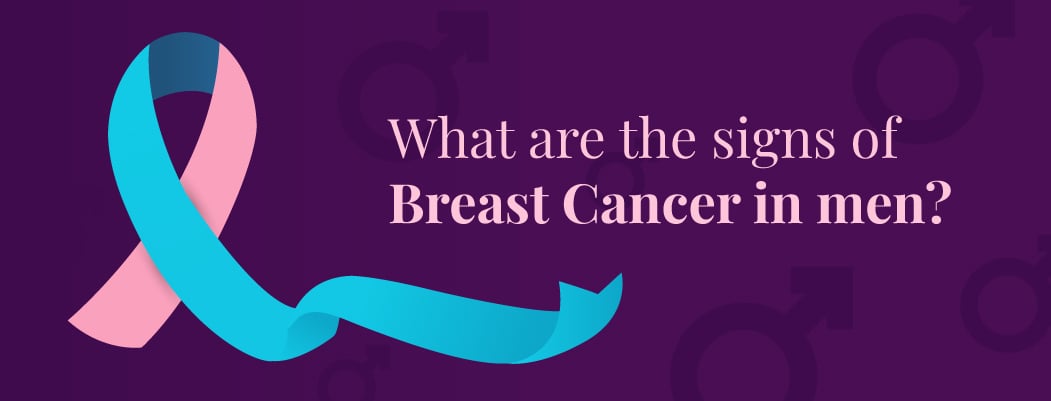How To Detect Breast Cancer In Male
December 27, 2022

Men have some breast tissue, though not as much as women do. A man’s “breasts” are identical to a girl’s before puberty. However, men’s tissue does not grow and develop like that of girls.
However, males can develop breast cancer since they still have breast tissue. Men and women both develop certain types of breast cancer; however, cancers affecting the organs responsible for producing and storing milk are uncommon. A man has a one in 1,000 chance of developing breast cancer over his lifetime.
The severity of breast cancer in men used to be thought by doctors to be greater than that in women, but it now appears to be roughly the same.
The main issue is that men are frequently diagnosed with breast cancer at a later stage than women. Men may not be as sceptical of anything weird in that part of the body, which could explain why.
What Is Male Breast Cancer?
Breast cancer can also affect men, but women are more prone to do so. Many people are unaware that males can develop breast tissue and breast cancer. Any cell in the body has the potential to become cancerous and spread to different areas.
When breast cancer first appears, breast cells begin to grow out of control. Tumours, which are commonly palpable lumps or apparent on x-rays, are typically formed from these cells. The tumour is regarded as malignant if its cells have the potential to spread to nearby tissues or other sections of the body (cancer).
Male breast tissue
Under the nipple and areola, young boys and girls have little breast tissue until puberty, which normally happens at age 9 or 10. The female hormones that a girl’s ovaries generate when she enters puberty lead her breast ducts to enlarge and form lobules at the ends of them. Even after puberty, male hormone levels in boys and men are frequently low, and breast tissue doesn’t enlarge considerably. Men’s breast tissue has few or no lobules, but there are ducts instead.
Where does breast cancer begin?
Different areas of the breast might serve as the origin of breast cancer. Most breast cancers start in the milk ducts leading to the nipple (ductal cancers). Some begin in the breast milk-producing glands (lobular cancers). Even though they aren’t usually utilized, men, too, have these ducts and glands. Other breast cell types can potentially develop breast cancer. However, this is a less usual occurrence.
Occasionally, breast cancers develop in tissues other than the breast. Sarcomas and lymphomas are the names of these cancers, which are not typically thought of as breast cancers.
Not all forms of breast cancer result in breast lumps, despite the fact that many do. You should keep an eye out for more breast cancer symptoms and report them to a doctor.
Additionally, it’s critical to understand that most breast lumps are benign and not cancerous (malignant). Although benign breast tumours are abnormal growths, they are not life-threatening and do not spread outside of the breast. A doctor should examine any breast lump or change to identify whether it is benign or malignant (cancer) and whether it may increase your chance of developing cancer in the future.
How breast cancer spreads?
Breast cancer can spread when cancer cells travel to other parts of the body through the lymphatic or circulatory systems.
The body is covered in a network of lymphatic veins, which make up the lymph system. The lymph veins carry lymph fluid between lymph nodes. Tiny, bean-shaped lymph nodes are where immune system cells are concentrated. Lymphatic vessels, which resemble tiny veins, carry a clear fluid called lymph, not blood, out from the breast. Lymph contains waste products, immune system cells, and tissue fluid. Breast cancer cells can move through the lymphatic system and grow in lymph nodes. Most of the lymphatic arteries in the breast empty discharge the lymph nodes under the arms (axillary nodes).
The lymph nodes near the collarbone (supraclavicular [above the collar bone] and infraclavicular [below the collar bone] lymph nodes).
Lymph nodes inside the chest, close to the breastbone (internal mammary lymph nodes).
There is a larger possibility that the cancer cells have gone via the lymphatic system and spread (metastasized) to other parts of your body if cancer has already advanced to your lymph nodes. The likelihood that breast cancer will be identified in other organs increases with the number of lymph nodes that have breast cancer cells. This means that discovering cancer in one or more lymph nodes frequently has an impact on your treatment strategy. One or more lymph nodes will typically need to be surgically removed to determine whether the cancer has spread.
However, not all men with cancer cells in their lymph nodes develop metastases to other organs, and some men can acquire metastases despite not having cancer cells in their lymph nodes at the time.
Who Has a Higher Risk of Breast Cancer?
Breast cancer in men before the age of 35 is quite uncommon. With age, your risk of developing breast cancer increases. Men typically develop breast cancer between the ages of 60 and 70.
In addition, the following factors increase the risk of male breast cancer:
- A close female relative has breast cancer.
- History of chest radiation exposure
- Gynecomastia, or enlargement of the breasts as a result of drugs, hormone therapy, certain illnesses, or toxins.
- Use of oestrogen.
- The rare genetic disorder, Klinefelter’s syndrome.
- A severe liver disease known as cirrhosis.
- Testicular illnesses include mumps orchitis, testicular injuries, or undescended testicles.
- Obesity.
Symptoms
Male breast cancer symptoms are comparable to female breast cancer symptoms. When a man feels a bump on his chest, he is usually diagnosed with male breast cancer.
However, males sometimes put off visiting the doctor until they have more severe symptoms, including nipple bleeding. Cancer might have spread by then.
Diagnoses and treatments
Men can be diagnosed with breast cancer using the same procedures as women, including physical examinations, mammography, and biopsies (looking at small samples of tissue under a microscope).
Men and women typically receive the same treatments. A combination of treatments, such as:
Surgery:
A mastectomy, where your entire breast is removed, is the normal therapy for men. Sometimes, breast-conserving surgery is performed in which only the tumour is removed. In order to check for cancer spread, the surgeon frequently removes one or more lymph nodes as well.
Radiation therapy:
After surgery, you could get radioactive rays or particles as treatment. Any cancer cells that surgery missed may be helped to eradicate by it. Radiation may be your main therapy option if the cancer is incurable.
Chemotherapy:
You will get medications orally or in injectable during this treatment to combat the cancer cells. You could receive chemotherapy after surgery to reduce the likelihood of the cancer returning. Chemotherapy may be the main treatment for men with advanced cancer or cancer that has spread to other parts of the body.
Hormonal therapy:
Some forms of breast cancer require particular hormones to develop. By blocking these hormones’ actions, this treatment slows the spread of cancer. Because around 90% of men’s malignancies are hormone receptor-positive, it frequently works better in males than in women. Certain male hormones can occasionally be reduced in the body’s levels as a result of testicular removal. Because testosterone encourages the growth of breast cancer cells, men with breast cancer should never take it. After surgery, hormone therapy may be used to reduce the likelihood of the cancer returning. It could be the main course of treatment for males with locally advanced or metastatic cancer.
Targeted therapy:
Some males have an overabundance of HER2, a protein that speeds up the spread of cancer. It prevents the growth of cancer cells caused by this protein. Additionally, it might strengthen your immune system and give it more power to fight cancer.
Remember, like anyone who has breast cancer or who has recovered from it, you’ll need to have checkups with your doctor for the rest of your life. Getting regular medical care is key to staying healthy.
Who treats male breast cancer?
A medical oncologist is an expert in treating breast cancer in men.
People also ask
Is breast Cancer possible in male?
Yes. Males can also develop breast cancer, although women are more likely to develop it than men. The chance of getting breast cancer in males is 1 in 1000.
What is the survival rate of male breast cancer?
For male breast cancer patients, the 5-year survival rate is 84%. The disease stage at the initial diagnosis is one of many variables that affect each person’s chance of survival. Men with breast cancer have a 97% 5-year survival rate if the disease affects the breast.
At what age can a male get breast cancer?
As a man becomes older, his chance of breast cancer rises. Men in their 60s are most frequently diagnosed with male breast cancer. Breast cancer in men before the age of 35 is quite uncommon.








